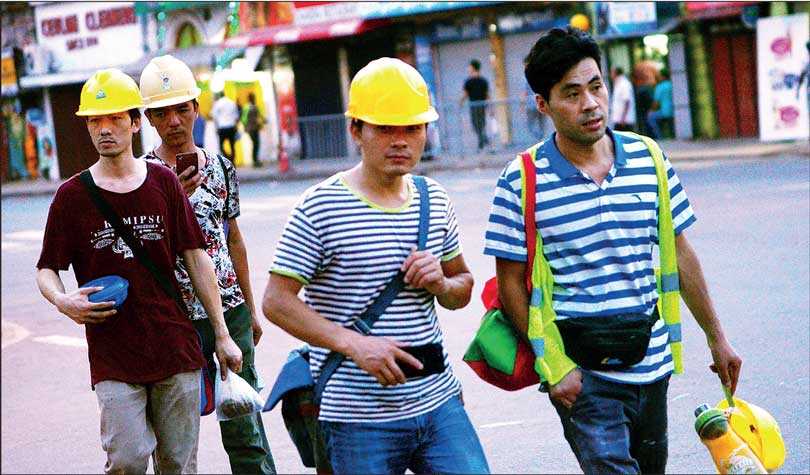Saturday Dec 28, 2024
Saturday Dec 28, 2024
Saturday, 24 April 2021 00:06 - - {{hitsCtrl.values.hits}}

What has happened since the end of the civil war, particularly under the rule of the Rajapaksa dynasty, can be described as a gradual Sinification of Sri Lanka, not in its cultural sense but in its economic, diplomatic and strategic sense – Pic by Shehan Gunasekara
 While to other countries, the Indian Ocean is only one of the important oceanic areas, to India it is the vital sea. Her life lines are concentrated in that area. Her future is dependent on the freedom of that water surface. No industrial development, no commercial growth, no stable political structure is possible for her unless the Indian Ocean is free and her own shores fully protected. The Indian Ocean must therefore remain truly Indian – K.M. Panikkar, India and the Indian Ocean, London: George Allen & Unwin Ltd., 1945, p. 84.
While to other countries, the Indian Ocean is only one of the important oceanic areas, to India it is the vital sea. Her life lines are concentrated in that area. Her future is dependent on the freedom of that water surface. No industrial development, no commercial growth, no stable political structure is possible for her unless the Indian Ocean is free and her own shores fully protected. The Indian Ocean must therefore remain truly Indian – K.M. Panikkar, India and the Indian Ocean, London: George Allen & Unwin Ltd., 1945, p. 84.
The Indian Ocean is once again at the centre of major geopolitical competition. China’s growing footprint and influence in the Indian Ocean Region (IOR) has made the contest for power and control in the region between China and the US and its partner has been significant. … India has long been wary of power-plays in the Indian Ocean, but finds itself with few options today but to participate in securing a free and open Indo-Pacific – Rajeswari Pillai Rajagopalan, ‘Countering Chinese assertiveness: India’s changing posture in the Indian Ocean,’ https://www.orfonline.org/research/countering-chinese-assertiveness-indias-changing-... 20/04/2021.
Indian Ocean geopolitical stature
Between what Panikkar asserted in 1945 and Rajagopalan’s observation in 2021 over three quarters of a century has lapsed, and within that period, the Indian Ocean (IO) has changed its geopolitical stature from Indian to Indo-Pacific. The Port City of Colombo, which is for all intents and purposes is emerging as a Chinese Port City, is part of the changes taking place in IO. China is at the centre of these changes.
The IO carries today, two-thirds of world’s oil shipment, one-third of its bulk cargo and one-half of the container traffic. IO also touches the borders of 40 nation states with 40% of the world’s population, stretching from Australia, to Southeast Asia, South Asia, West Asia and to the eastern seaboard of Africa. Given the enormity and significance of this IO traffic to the world, India cannot even dream of monopolising that oceanic artery without being challenged. Yet, India, like China, is a rising regional power and therefore concerned over China’s intentions to increase her naval strength in IO.
China’s economic model
After 1976, when China adopted a purposely designed capitalist economic model without relinquishing the communist political infrastructure, the country’s master plan was to achieve global domination, both economically as well as in military terms. One of China’s immediate steps to implement that plan was to safeguard the country’s sea lines of communication (SLOC).
According to UNCTAD, nearly 60% of the total value of China’s trade passes through the South China Sea and IO. Thus, like Persian Gulf in the Middle East, IO in Asia is the arterial seaway which China needed to protect and control. In other words, China decided to replace the old land-based Silk Road by a new sea based One Belt Road. What came to be known as the String of Pearls strategy of China was dictated by that need.
Sri Lanka’s civil war provided a golden opportunity for China to add one more pearl to that string. It was a war won virtually by China for Sri Lanka. The Independent (23 October 2011), summarised how it happened in the following words: “When the US ended direct military aid in 2007 over Sri Lanka’s deteriorating rights record, China leapt into the breach, increasing aid to nearly $ 1 b… to become the island’s biggest donor, giving tens of millions of dollars’ worth of sophisticated weapons, and making free gift of six F7 fighter jets to the Sri Lankan air force. China encouraged its ally Pakistan to sell more arms and to train pilots to fly the new planes. And, crucially, China prevented the UN Security Council from putting Sri Lanka on its agenda.”
With that victory and the then President Rajapaksa’s gratitude to China, its penetration into the island to gain a permanent foothold was only a matter of time. After that, the Hambantota project, initiated by the Rajapaksa Presidency, and to which no other country except China was willing to finance, drove the island further into China’s arms, just as US’ reluctance to support Nasser’s Aswan Dam in 1950s pushed Egypt into the Soviet camp.
It appears from revelations by one of the Rajapaksas that even the Sinharaja reservoir project was planned to be constructed with Chinese engineering at that time (See Tisaranee Gunasekera, ‘Birth Pangs of the Rajapaksa Satrapy,’ Colombo Telegraph, 18 April 2021). It is still remaining unaccomplished because of UNESCO’s concerns over Sri Lanka’s natural heritage. The Mattala Airport, another of Rajapaksa’s white elephants, deepened China’s involvement further.
 The return of the Rajapaksas
The return of the Rajapaksas
The change of government in 2015 and Yahapalana regime’s internal squabbles and ineffectual governance, although slowed down China’s involvement, yet, the new regime solidified China’s foothold by leasing to her the Hambantota harbour for 99 years.
The return of the Rajapaksas in 1919/20 made Sri Lanka’s Sinification unstoppable. When the Government, in a move to counterbalance China’s weight decided to offer India and Japan the development and operation of the East Container Port Terminal, there were massive protests by trade unions and Buddhist monks, apparently instigated by China. (There were rumours that China even paid the protestors).
Sri Lanka’s historic antipathy towards India was also a factor that was exploited to provoke the melee. Eventually, that offer was withdrawn, and as compromise, President NGR offered India and Japan the West Container Terminal. Whether India accepted that offer is not clear yet.
The plan to open a university of technology in Hambantota with China’s help is another mile post along the road towards Sinification. The Colombo Port City (CPC) project built at India’s doorstep by the China Harbour Engineering Corporation is the latest venture to strengthen China’s Maritime Silk Road, and particularly its China-Pakistan-Sri Lanka Economic Corridor.
The Rajapaksa regime claims that it is going to be a mega investment zone under special jurisdiction and would be the panacea for all the financial troubles facing the nation. On the contrary, economists and financial experts, both local and foreign fear that CPC would become a mega tax haven and money laundering magnet, and most of its benefits would go to China rather than Sri Lanka. Colombo Telegraph (22 April 2021) reported that the President’s Counsel let the cat out of the bag when he addressed the Supreme Court and argued that there was nothing wrong in President NGR allowing China to govern the CPC.
Even when COVID-19 hit the economy last year the Central Bank was encouraging the wealthy with foreign currency holdings to bring the funds back to the country without questions being asked. Illicit money may now flow legally through CPC.
The Colombo Port City Economic Commission (CPCEC) to be appointed by the President will not be answerable to the Parliament, which means CPC would virtually remain a state within a state and as a Chinese Port City in Colombo. Several petitions filed against the CPC and CPCEC are pending judgement from the Supreme Court. But with a history of political interference in the Judiciary, one cannot have too much confidence in the verdict of the judges. It is obvious that China did not invest all that money in building CPC to enable someone else to benefit, let alone Sri Lanka.
Sinification of Sri Lanka
What has happened since the end of the civil war, particularly under the rule of the Rajapaksa dynasty, can be described as a gradual Sinification of Sri Lanka, not in its cultural sense but in its economic, diplomatic and strategic sense. If that trend continues the country would inevitably become another client state of China like Myanmar. The country has tilted too far towards China and has sunk deeply into China’s geopolitical vortex.
Recently, NGR announced that he would renegotiate with China about the Hambantota lease. China’s response was to foot drag the release of $500 million loan promised to the government. China is also aware that the regime is losing its popularity and there is information that Chinese diplomats are secretly in contact with the opposition.
However, just a change of regime at the next general elections without a wholesale transformation of Sri Lanka’s diplomatic cadre and foreign policymakers would not be sufficient to bring about a reversal in Sinification. It was the country’s inexperienced and politically appointed diplomats and the Government’s muddled foreign policy, that caused the recent setback in Geneva. Small nations like Sri Lanka have no alternative but to remain non-aligned to advance their interests amidst rivalry among big powers. The IO is now emerging as the hotspot for maritime power struggle. The contestants are not only India and China, but also US and its European and Pacific allies, including Japan and Australia. The Rajapaksa regime with its one-way route to China has obviously put off India and its Western allies. How these countries would react when CPC with its CPCC comes into operation will be interesting to watch.
China will not surrender so easily what it has gained already in Sri Lanka. China’s Minister of Defence is expected to arrive soon in Colombo and NGR is also expected to visit Peking. One would hope some wisdom to prevail in forthcoming negotiations to prevent Sri Lanka becoming China’s satellite.
(The writer is attached to the School of Business and Governance, Murdoch University, Western Australia.)